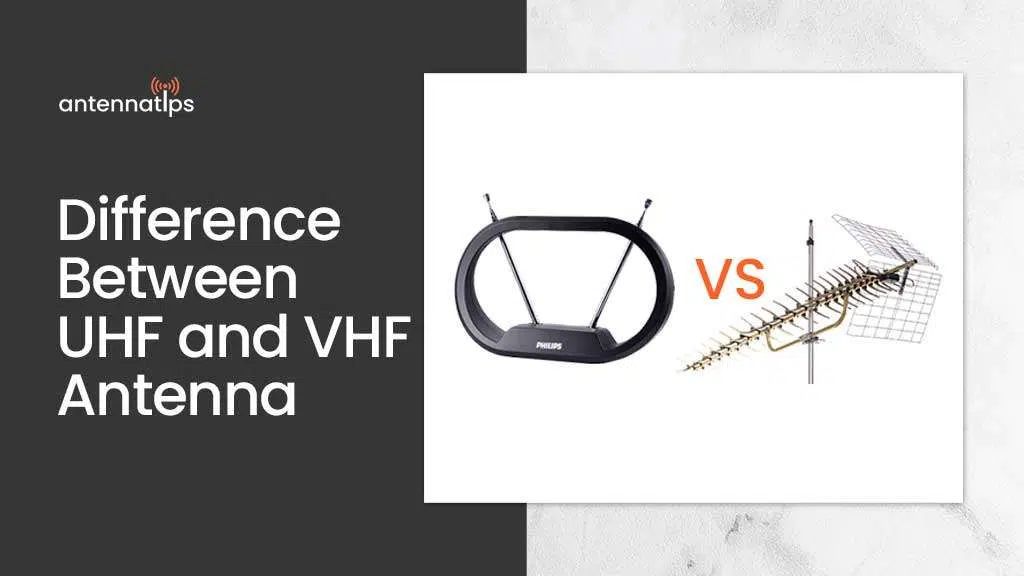
Monthly cable subscriptions can definitely add to your stack of monthly bills! That being said, it is one of our most convenient, as well as easy, methods of relaxation. Why deprive yourself of a movie marathon during the weekends? After all, you’ve worked hard for it.
But what if you can still watch your favorite shows without an expensive monthly subscription. Cutting the cord is possible if you have the right antenna. But what is the difference between a UHF and VHF antenna?
TV signals are broadcasted on either a UHF or VHF frequency. Which means, your favorite TV channels are also coming from one or the other of those two frequencies. That said, it’s important to know which of these two frequencies will be responsible for pulling your favorite channels in, for you to enjoy! Let’s find out how.
Lets Find out the Difference Between a UHF and VHF Antenna
What’s the difference between these two bandwidths?
UHF
- UHF has higher frequencies between 470 and 89 megahertz. Since UHF signals can carry signals farther without interference, it can provide you HD channels.
- UHF channels are numbered higher. Say, in the US, UHF channels are numbered 14-83.
- It has a shorter wavelength. Thus, it can bypass obstructions better than VHF signals.
VHF
- VHF frequencies can transmit signals between 54 and 216 megahertz.
- VHF channels are numbered 2-13
- It’s usually used in FM and marine band radio. So you can’t expect clear and crisp pictures with it.
How Can You Differentiate a UHF from a VHF Antenna?
It’s quite easy and simple to know whether an antenna has UHF or VHF signal capacity.
Since UHF signals have shorter bandwidth, it will appear as shorter elements on the antenna. The element is just a few inches wider. And they usually appear like straight prongs or arranged in parallel rows.
VHF, on the other hand, appears longer since it has a longer bandwidth. You can readily tell that an antenna has VHF capacities with the V-shaped element.
Additionally, there are a lot of antennas that have both UHF and VHF capability. So you would see the elements combined in the antenna.
UHF vs VHF, Which Antenna to Get?
Deciding which antenna to buy is easier than you think. Here are several factors that you can consider.
- What channels do you want to watch? Remember UHF channels are numbered 14-83 while VHF channels are 2-13.
- Say you’re watching a specific channel that’s available on both bandwidths. You have to determine which bandwidth has a greater signal for that specific channel.
- Alternatively, you can hover through the website of the Federal Communication Commission to see which channels are available on each bandwidth.
How to Choose the Best VHF Antenna?
VHF channels may not be your cup of tea when it comes to watching crisp images. But it’s one of the most indispensable marine electronics. It can save your life from a sea emergency.
So how to spot the right VHF antenna?
- Typically you can choose from one that clouds go on from a range of 10 miles to 25 plus miles.
- You also have to consider the antenna height and gain. Boats under 24 feet would benefit largely from a 3 to a 4-foot antenna with 3 Db. If you have a larger sea vessel, on the other hand, a 12 to 18 foot, with 8 dB antennas would suffice.
- Keep in mind that the antenna length should be half the length of the boat.
You may also like: Best Omnidirectional Outdoor TV Antenna
Which is Better to Get, UHF or VHF Antenna?
That depends on where you’re going to use it.
VHF antennas are ideal for outdoor use and long-distance. Thus, signals are used in boats and sea vessels. It’s also suited when you’re camping or staying in an RV.
UHF antennas, on the other hand, are suitable for indoor use. It’s ideal for wireless connections. And these signals can overcome obstructions such as roofing materials better than VHF antennas.
Alternately, to get the best of both worlds, you can choose an antenna that has both capacities. And if you want your antenna to receive digital channels, it has to be equipped with both VHF and VHF bandwidths.
FAQ’s
What about for antennas that do not have visible elements, how will I know if it has VHF or UHF capabilities?
What’s the difference between a low VHF and a high VHF antenna?
Will a UHF antenna pick up VHF channels?
How can I get most local channels in my area?
Conclusion
It’s fairly easy to spot the difference between a UHF and VHF antenna. And consequently, the question as to which bandwidth is better follows. Remember, VHF antennas are better suited where open terrain is involved. Thus, we are looking at outdoor applications.
UHF signals, on the other hand, are of indoor use since they can penetrate through bricks and walls better. You can get the most bang for your buck if you’ll buy an antenna with both UHF and VHF signals.